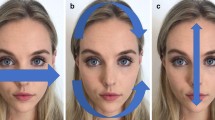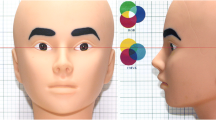Abstract
Background
Photography standardization is paramount for appropriate critical analysis of aesthetic surgery outcomes. Therefore, the authors designed a study to evaluate the influence of different variables in photos of patients with indications for undergoing facial rejuvenation.
Methods
This blinded prospective study was conducted by the Section of Plastic Surgery in the Hospital das Clínicas at the Federal University of Paraná. In the study, 29 patients had their photos taken in two separate settings. Photo 1, termed “preoperative” (Pre), was obtained according to the same pattern for all patients. Photo 2, termed “postoperative” (Post), was acquired on the same day using different variables to manipulate the photo outcome. No surgery was actually performed. Both photos (Pre and Post) were sent to five experienced Brazilian plastic surgeons, who provided a score for photo 2 that varied from −10 to +10 compared with photo 1.
Results
The photos were examined by 119 plastic surgeons. No significant improvement was observed in most of the groups, except for the group that used a flash for the Post photography (p = 0.035). Almost half of the scores (45.37 %) were above zero. The highest score was found to be ten for two photographs of the makeup group. A score of zero was assigned to 54.62 % of the photos, which means no changes occurred between the Pre and Post photos.
Conclusion
Inadequate photographic technique can change assessments of photos in a meaningful way. All the factors evaluated had a positive impact, but the only statistically significant variable was the use of a flash in the Post group.
Level of Evidence II
This journal requires that authors assign a level of evidence to each article. For a full description of these Evidence-Based Medicine ratings, please refer to the Table of Contents or the online Instructions to Authors www.springer.com/00266.








Similar content being viewed by others
References
Pham AM, Tollefson TT (2010) Objective facial photograph analysis using imaging software. Facial Plast Surg Clin North Am 18:341–349
Galdino GM, Vogel JE, Kolk CAV (2001) Standardizing digital photography: it’s not all in the eye of the beholder. Plast Reconstr Surg 108:1334–1344
Henderson JL, Larrabee WF, Krieger BD (2005) Photographic standards for facial plastic surgery. Arch Facial Plast Surg 7:331–333
Kuhnnel T, Wolf S (2005) Mirror system for photodocumentation in plastic and aesthetic surgery. Br J Plast Surg 58:830–832
Persichetti P, Simone P, Langella M, Marangi GF, Carusi C (2007) Digital photography in plastic surgery: how to achieve reasonable standardization outside a photographic studio. Aesthetic Plast Surg 31:194–200
Dibernard BE, Adams RL, Krause J, Fiorillo MA, Gheradini G (1998) Photographic standards in plastic surgery. Plast Reconstr Surg 102:559–568
Stephan CN, Cicolini J (2010) The reproducibility of facial approximation accuracy results generated from photo-spread tests. Forensic Sci Int 10:133–137
Archibald DJ, Carlson ML, Friedman O (2010) Pitfalls of nonstandardized photography. Facial Plast Surg Clin North Am 18:253–266
Sommer DD, Mendelsohn M (2004) Pitfalls of nonstandardized photography in facial plastic surgery patients. Plast Reconstr Surg 114:10–14
Swamy RS, Most SP (2010) Pre- and postoperative portrait photography: standardized photos for various procedures. Facial Plast Surg Clin North Am 18:245–252
Daniel RK, Hodgson J, Lambros VS (1990) Rhinoplasty: the light reflexes. Plast Reconstr Surg 85:859–866
Turk K (2009) Minimalist lighting: professional techniques for studio photography, 1st edn. Amherst Media, New York
Peck JJ, Roofe SB, Kawasakid DK (2010) Camera and lens selection for the facial plastic surgeon. Facial Plast Surg Clin North Am 18:223–230
Swamy RS, Sykes JM, Most SP (2010) Principles of photography in rhinoplasty for the digital photographer. Clin Plast Surg 37:213–221
Riml S, Piontke A, Larcher L, Kompatscher P (2011) Quantification of faults resulting from disregard of standardised facial photography. J Plast Reconstr Aesthet Surg 7:898–901
Reha Yavuzer R, Smirmes S, Jackson IT (2001) Guidelines for standard photography in plastic surgery. Ann Plast Surg 46:293–300
Humphrey CD, Kriet JD (2010) Intraoperative photography. Facial Plast Surg Clin North Am 18:329–334
Conflict of interest
None of the authors has a financial interest in any of the products, devices, or drugs mentioned in this manuscript.
Author information
Authors and Affiliations
Corresponding author
Rights and permissions
About this article
Cite this article
Scomação, I.R., Graf, R.M., Maluf, I. et al. Evaluation of Photographic Variables in Patients with Indication for Facial Rejuvenation. Aesth Plast Surg 37, 1114–1119 (2013). https://doi.org/10.1007/s00266-013-0222-1
Received:
Accepted:
Published:
Issue Date:
DOI: https://doi.org/10.1007/s00266-013-0222-1




